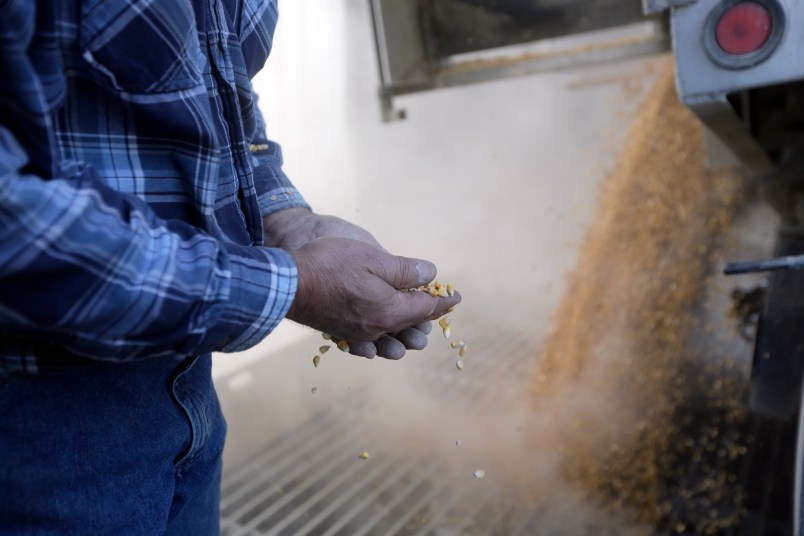WASHINGTON (AP) — The huge, five-year farm bill that Congress sent to President Obama on Tuesday sets policy for hundreds of programs, including farm subsidies and food stamps. It would make small cutbacks to both, eliminating some subsidy programs and cutting the $80 billion-a-year food stamp program by $800 million a year, or 1 percent. Conservatives had proposed much higher cuts.
Some questions and answers about the farm bill and its politics:
Q: What is the farm bill?
A: It’s a wide-ranging bill, usually written every five years, that sets policy for government farm subsidies and some of the country’s nutrition programs, including food stamps. It also sets dollar levels for the Agriculture Department and subsidizes farmers and rural communities for a multitude of things — from protecting environmentally sensitive land to international food aid to rural Internet services.
Q: How much does it cost?
A: Broken down by year, the bill is expected to cost around $96 billion annually.
Q: Where does most of that money go?
A: Almost 80 percent of the money will go to food stamps for the needy — now called the Supplemental Nutrition Assistance Program, or SNAP. It has more than doubled in cost since 2008 due to the economic downturn, fluctuating food prices and eligibility requirements loosened in the 2009 economic stimulus bill. In 2013, an average of 47.6 million people used SNAP at a cost of $79.6 billion. Around 15 percent of the money in the farm bill is designated for farm subsidies and crop insurance subsidies. The rest would go to conservation, rural development, renewable energy and other farm programs.
Q: Where’s the support in Congress?
A: The farm bill has always passed with the support of a coalition of rural lawmakers interested in farm programs and urban lawmakers with high numbers of voters in their districts on food stamps. Several decades ago, lawmakers combined nutrition programs with agricultural supports in the farm bill to gain those urban votes. The number of rural lawmakers has dwindled in recent years, though, and the escalating cost of food stamps threatened the bill this time around as conservatives say the SNAP program has spiraled out of control and needs to be cut.
Q: How did they decide on a cut of $800 million a year?
A: It was a compromise between the Senate bill, which would have cut $400 million a year, and the House bill, which would have cut $4 billion a year. The White House had threatened to veto the House bill, and Senate Democrats made it clear they would not go much higher. The money would come from ending the practice in some states of giving recipients a minimal amount of heating assistance in order to trigger higher food stamp benefits. Some critics see that as an abuse of the system.
Q: Who is opposing it?
A: Conservatives have said the food stamp cuts aren’t high enough and liberals have said they are too high. Some conservatives also have criticized the amount of farm subsidies in the bill, and the groups Club for Growth and Heritage Action have said they will use it against Republicans who voted for it in primary campaigns.
Q: With all of that opposition, how did the bill pass?
A: Senate Agriculture Chairwoman Debbie Stabenow, D-Mich., and her House counterpart, Republican Rep. Frank Lucas of Oklahoma, crafted the bill with support for all regions and lowered the food stamp cuts enough that it won support from many Democrats. Conservative Republicans voted against the bill in both chambers, but GOP leadership supported it and more moderate Republicans did too.
Q: Does Obama support it?
A: The White House has stayed mostly quiet through the process but issued support for the final compromise when it was released last week. On Tuesday, Obama said the bill isn’t perfect but reduces deficits “without gutting the vital assistance programs millions of hardworking Americans count on to help put food on the table for their families.”
Q: What about farm subsidies?
A: The bill would eliminate subsidies called direct payments, which cost about $4.5 billion a year and are paid to farmers whether they farm or not. But it uses most of those savings to create new farm subsidies and expand crop insurance.
Q: Why does the government subsidize farmers?
A: Farm-state lawmakers have traditionally argued that farmers need a government safety net because agriculture is a tough, unpredictable industry and the nation’s food supply is dependent on family farms staying in business. Critics say too much of the money goes to wealthy farmers and large, corporate agribusinesses.
Q: Are there overall savings in the bill?
A: The bill would save around $1.65 billion annually overall, but critics say those savings could be erased if the weather or the market doesn’t cooperate. Many of the new subsidies would only kick in if a farmer has losses, and it’s impossible to predict exactly how much the programs will eventually cost.
__
Follow Mary Clare Jalonick on Twitter at http://twitter.com/mcjalonick
Copyright 2014 The Associated Press. All rights reserved. This material may not be published, broadcast, rewritten or redistributed.






